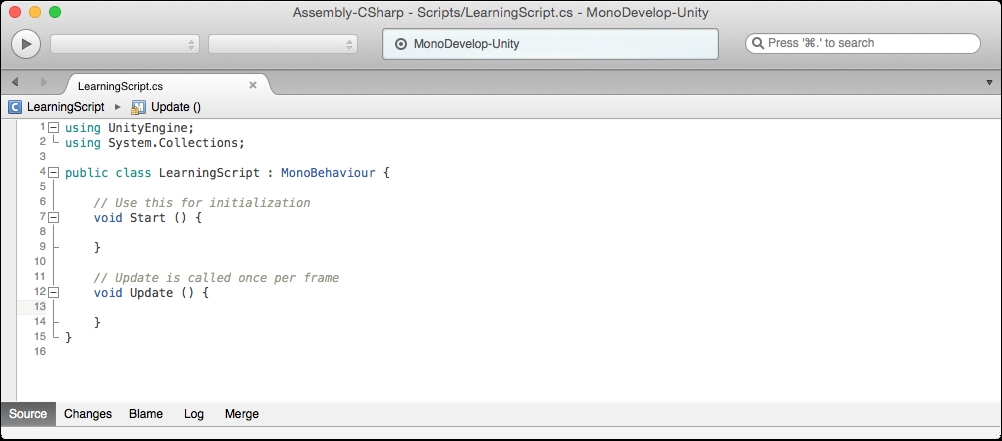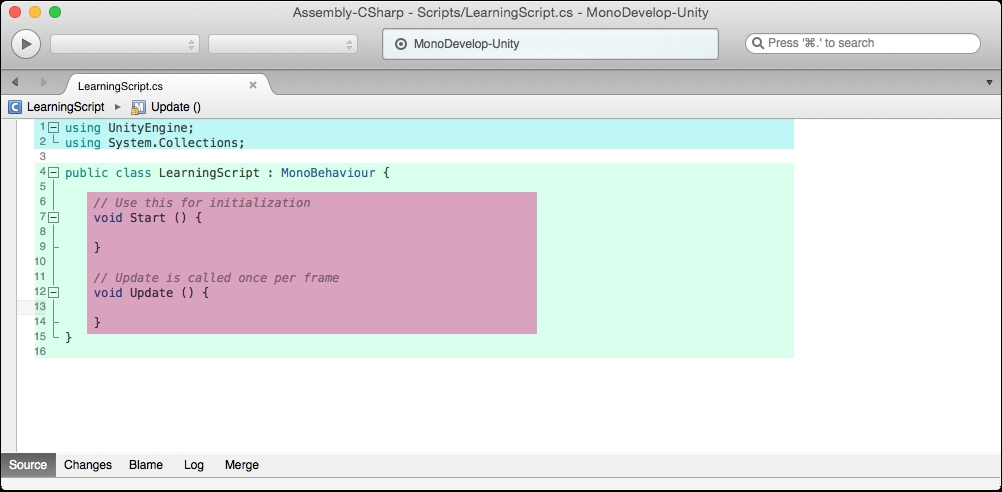Unity uses an external editor to edit its C# scripts. Even though it can create a basic starter C# script for us, we still have to edit the script using the MonoDevelop code editor that's included with Unity.
Since Unity and MonoDevelop are separate applications, Unity will keep MonoDevelop synchronized with itself. This means that if you add, delete, or change a script file in one application, the other application will reflect the changes automatically.
Unity will synchronize with MonoDevelop the first time you tell it to open a file for editing. The simplest way to do this is by double-clicking on LearningScript in the Scripts folder. It might take a few seconds for MonoDevelop to open and sync.
Our window should look like this:

MonoDevelop launched with LearningScript open, and ready to edit.
What we see now is a default C# script structure that Unity creates. It contains information on what namespaces are used in the script, the class definition, and two methods that Unity adds by default, as shown here:

The namespace is simply an organization construct. It helps organize parts of code. Don't worry too much about them now. We won't need to create them anytime soon. All we will need to know for now is how many namespaces we are using in our script.
In our script, we can see these two lines:
using UnityEngine; using System.Collections;
The preceding two lines simply mean that our script will be using the UnityEngine and System.Collections namespaces and we will have access to all parts of these libraries. These two namespaces are added to any new C# script by default, and we will use them in most of our cases.
A class definition starts with the class keyword, followed by a class name and an optional base class name, followed by a class body enclosed in curly braces:
public class LearningScript : MonoBehaviour {
}Tip
Downloading the example code
You can download the example code files for this book from your account at http://www.packtpub.com. If you purchased this book elsewhere, you can visit http://www.packtpub.com/support and register to have the files e-mailed directly to you.
You can download the code files by following these steps:
Log in or register to our website using your e-mail address and password.
Hover the mouse pointer on the SUPPORT tab at the top.
Click on Code Downloads & Errata.
Enter the name of the book in the Search box.
Select the book for which you're looking to download the code files.
Choose from the drop-down menu where you purchased this book from.
Click on Code Download.
Once the file is downloaded, please make sure that you unzip or extract the folder using the latest version of:
WinRAR / 7-Zip for Windows
Zipeg / iZip / UnRarX for Mac
7-Zip / PeaZip for Linux
Again, don't worry about this too much. Let's not introduce too much theory. All that we need to focus on now is how the class definition looks.
Notice line 4 in the preceding screenshot:
public class LearningScript : MonoBehaviour
The class name LearningScript is the same as the filename LearningScript.cs. This is a requirement. You probably don't know what a class is yet, but that's okay. Just remember that the filename and the class name must be the same.
When you create a C# script file in Unity, the filename in the Project tab is in Edit mode, ready to be changed. Please rename it right then and there. If you rename the script later, the filename and the class name won't match. The filename would change, but line 4 will be this:
public class NewBehaviourScript : MonoBehaviour
This can easily be fixed in MonoDevelop by changing NewBehaviourScript in line 4 to the same name as the filename, but it's much simpler to do the renaming in Unity immediately.
What happens when Murphy's Law strikes and syncing just doesn't seem to be working correctly? Should the two apps somehow get out of sync as you switch back and forth between them for whatever reason, do this. Right-click on Unity's Project window and select Sync MonoDevelop Project. MonoDevelop will resync with Unity.
We have created the LearningScript class. Its code is saved in the file in the Project/Assets folder. To include an instance of this class in our project, we will add it as a component to an empty GameObject.
Lets create a new GameObject. In the menu, navigate to GameObject | Create Empty Child, as shown here:

There are a number of ways of adding our LearningScript component to GameObject. Let's talk about the simplest one:
We can now see that our LearningScript file has been added as a component to the GameObject. This means that an instance of LearningScript is active and ready to execute code.


































































